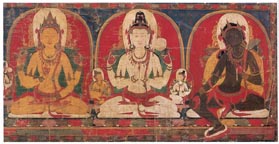| 10. Buddha with Attendants
|

10.
Buddha with Attendants
Central Tibet (a Kadampa monastery?), early 12th century
Distemper on cloth
201.4 x 114 cm (791/4 x 447/8 in.)
Private collection
click on image below for 10: Detail full screen view
|

10: Detail
|
|
This is the largest early Tibetan thanka known to survive, an exemplar of the size and majesty that these paintings
could achieve. The basic format of the picture is typical: a large main figure flanked by two willowy standing
bodhisattvas-in this case Padmapani to the right and Avalokiteshvara to the
left--and a chorus of seated figures
above them. Above the head of the Buddha are three lamas, probably Atisha (in the center) flanked by two
abbots, both of whom wear monastic robes. Below the main figure is a row of five deities; four of them are seated
against throne backs with the typical double upper rails surmounted by foliate scrolls. At the far right is a seated
Green Tara in lalitasana (a posture of ease). To her right are two four-armed seated deities. The first is Shadakshari Lokeshvara flanked by two diminutive attendants: Manidhara (to his right) and Shakadakshari Mahavidya (to his left);1 the second is possibly a four-armed yellow Manjushri. The fourth figure is a Buddha
seated against a bolster backed by an architectural throne. He too is flanked by two small attendants, a
ferocious kneeling red deity and perhaps another depiction of Shakadakshari Lokeshvara. Lastly, at the far
left is a horrific standing figure of Mahakala trampling on a prostrate Ganesha (the elephant-headed son of Shiva).
He is attended by a small kneeling donor figure wearing a simple monastic robe and assuming
anjali mudra, the gesture of adoration, toward him.
Several features of the painting point to an early date. If the group of lamas above the Buddha is
understood as an incipient lineage, like that seen in the Ford Tara (cat. no, 3), this would seem to indicate a
date of about 1100. The form of the Buddha's double lotus seat and the unusually tall and narrow nimbus are very
close to those of the Kronos Amoghasiddhi (cat. no. 4), although the Buddha's halo is more ovoid. The standing attendant bodhisattvas, although
much more attenuated, are closer to that early prototype--particularly in the balance of the
masses--than to later
examples where the forms become flattened and stylized. The chorus of ten listeners is also like in number to that
seen in the Kronos painting: most later ones depict six or eight. It is interesting that the outer figures in the lower
tier, although crowned, have neither an ushnisha, the cranial protuberance
indicative of transcendent wisdom, nor the tall chignon usually associated with bodhisattvas (see also cat. nos. 1,
4). This difference would seem to indicate that the chorus was composed of a variety of divine beings (also,
perhaps, bodhisattvas, in different states of progress toward enlightenment). Despite these connections, the
Buddha lacks the spatial coherence of the earlier picture and points the way to later derivations of the eastern
Indian style. The central position of Atisha and the two
flanking monks would seem to justify an attribution to a Kadampa monastery.
SMK
1. Mallmann 1948, pp. 173-75. [back]
|

